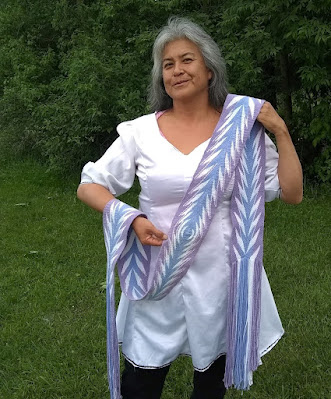Disclosure:
Affiliate links
to Amazon are included in this post.
Marilyn Isaacs is a Haudenosaunee ( also known as
Iroquois) weaver who specializes in making sashes, belts, and
garters for people to wear with their traditional regalia. Her belts and
sashes have earned awards and special recognition in various art shows
throughout New York. I recently had an opportunity to talk with her and
ask her some questions.

Marilyn Isaacs with one of her award-winning belts, 2019
What is fingerweaving?
Marilyn:
Fingerweaving is the art of weaving long fibers together to make
something stronger and new. In the past, people wove their belts with
natural fibers, with whatever they could find around them. Fibers from,
hemp, dogbane, cotton, and basswood were often used. Fibers made out of
animal fur or wool from sheep, llamas, buffalo, and whatever animals lived
around them were also used.
How did you learn fingerweaving?
Marilyn: When I was a teenager I was dancing a summer job at the Native American Center of the Living Arts in Niagara Falls, New York. (Some locals call it The Turtle because the building was built to look like a turtle.) I didn't have a belt for my regalia but wanted one. I found a book about fingerweaving in the bookshop and taught myself to weave. I didn't like my first belt so I gave it away. My weaving got better. I have been weaving for more than 30 years. A friend suggested that maybe weaving was "already in my DNA."
Marilyn Isaacs at a fingerweaving demonstration, 2020
What is the name of the book you learned from?
Marilyn: It's an old book from the 1970's. It's called Finger Weaving by Alta Turner.
What materials do you work with?
Marilyn: I've woven with acrylic, wool, and hemp. But cotton feels the best when I work with it, so I use that most often. I prefer natural fibers.
Belts, sashes, and armbands by Marilyn Isaacs
What items do you like to weave?
Marilyn: I make belts, sashes, arm ties, leg ties, and bands for cowboy hats. My specialty is making belts though. I also make purse straps and basket handles. When I work with kids, I teach them how to weave keychains.
Chevron belt by Marilyn Isaacs matched with fabric for a dress
What is it like to teach fingerweaving to children?
Marilyn: When I teach others to weave I love watching the a-ha moment when they actually grasp the weaving skill necessary to weave their project successfully. Some weaving students really struggle and need a quick review or complete reteaching but I understand that not all students have the same learning style. As a weaving teacher, I love proving a student wrong who says "I can't." When they continue to try again and learn how to perform the skill correctly, it's a very satisfying feeling for me as a teacher. When my students see their progress, they are encouraged to keep on weaving. This makes me smile and I hope to encourage them to learn to love weaving the way I do.
Keychains made by Marilyn Isaacs and some of her students, 2022
Why is it important for you to teach fingerweaving to others?
Marilyn: It is important to me because it's a cultural skill that is dying out
and needs to be revived. It is believed that Haudenosaunee Nations had
specific patterns they wore to identify themselves. However, we can't
verify this because many of these weavings no longer exist. They were
made from natural materials without any artificial preservatives applied
to them. Over time, these weavings disintegrated and were lost forever.
To learn more about Marilyn Isaacs and her fingerweaving, check out the
video below:
-YouTube video by Iroquois Museum-

Did you enjoy reading this post about finger weaving? If so, check out
these related Native American - Indigenous children's books and
activities:
- Book: Red Bird Sings: The Story of Zitkala-Ša by Gina Capaldi and Q.L. Pearce
- Book: We Are Water Protectors by Carole Lindstrom
- Book List: 10 Children's Books About Residential Schools
- Recipe: Indigenous - Native American Immune Boosting Pine and Cedar Tea

